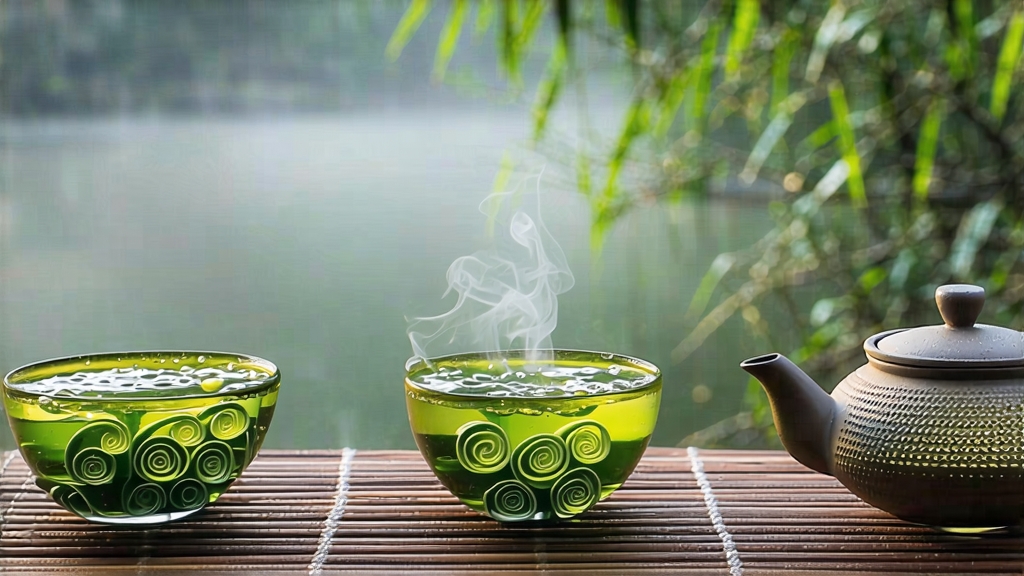
Biluochun, whose name translates literally to “Green Snail Spring,” is one of China’s ten most celebrated teas, yet it remains a quiet mystery outside the circles of serious tea lovers. Grown on the mist-locked, fruit-tree-capped hills that rise from the eastern shore of Taihu Lake in Jiangsu Province, this green tea is prized for the tight spiral shape of its leaf, its downy silver tips, and an aroma so naturally fragrant that the Qing-dynasty Emperor Kangxi is said to have renamed it on the spot when he first encountered it during his southern inspection tour in 1699. Before that imperial moment it was known by the humbler moniker “Xia Sha Ren Xiang”—“Scary Fragrance”—a nod to the overpowering perfume the tiny leaves release when they meet hot water.
History and Legend
Local chronicles trace Biluochun’s origin to the Tang dynasty (618-907), but its rise to fame occurred between the late Ming and early Qing when Suzhou-region monks began planting tea bushes between rows of peach, plum, and loquat trees. The intercropping was practical: fruit blossoms attracted pollinators while their scent drifted onto nascent tea buds, imprinting the leaf with a lingering floral sweetness. When Kangxi’s barge docked at Taihu, magistrates presented the tea in a covered porcelain cup. The moment the lid lifted, the spiral-shaped leaves unfurled like miniature jade snails and a fragrance of ripe apricot and spring orchid leapt up. The emperor, delighted, asked for the name; told it was “Scary Fragrance,” he replied that something so elegant deserved better, and christened it Biluochun—“green snail of spring.”
Micro-Terroir
Authentic Biluochun comes only from a narrow 10-kilometre band of hills in Dongting East and West Mountains—islands of weathered granite thrust into Taihu’s shallow waters. The lake acts as a giant heat reservoir, moderating temperature and bathing the slopes in a perpetual veil of vapor. Morning mist filters ultraviolet light, slowing photosynthesis and concentrating amino acids, especially L-theanine, which gives the tea its brothy sweetness. Soils are acidic, rich in quartz and iron, and drain quickly; roots struggle, yielding smaller leaves with higher aromatic oil content. Even within this micro-zone, altitude matters: bushes above 200 m ripen two weeks later than those at lakeside, developing more complex sugars and a cooler, greener fragrance.
Varietal Nuances
Although all Biluochun belongs to the species Camellia sinensis var. sinensis, three clonal selections dominate:
- Dongting Original—seed-propagated old stock, tiny one-bud-one-leaf sets, pale liquor, white peach nose.
- Wuniuzao (“Five-Early”)—a 1970s selection that flushes 15 days sooner, yielding larger spirals and a brighter, grassier cup; 70 % of commercial production.
- Chuanbi No. 1—high-yield cultivar bred for resistance to lake fog fungi; bolder taste, slightly astringent, often used in blended grades.
Harvest Calendar
Pickers begin work when lake mist still hangs at knee height, usually between the Qingming festival (early April) and Grain Rain (late April). Pre-Qingming Biluochun—mingqian—consists solely of unopened buds no longer than 2 cm; 50 000 of them make 500 g of finished tea. Guyu-grade, picked up to 20 April, includes one unfolded leaf and delivers a fuller, slightly nuttier cup. Anything later is classified as “spring tip” and rarely bears the Biluochun name at auction.
Crafting the Spiral
The transformation from fragile bud to durable, snail-shaped tea is a six-hour ballet of heat, pressure, and timing carried out the same day as harvest.
- Withering / Shu Qing: Leaves are spread 2 cm deep on bamboo trays set in shaded draft for 60–90 minutes, losing roughly 10 % moisture and acquiring the flexibility needed for rolling without snapping.
- Primary Kill-Green / Sha Qing: A wok heated to 180 °C receives 250 g of leaf. The master’s bare hand flips and presses the mass for 3–4 minutes, deactivating oxidative enzymes while preserving green chlorophyll. Temperature is judged by the sound of sizzling water droplets flicked from fingertips—